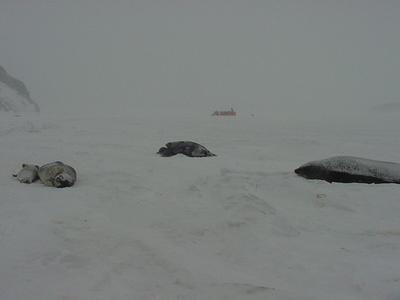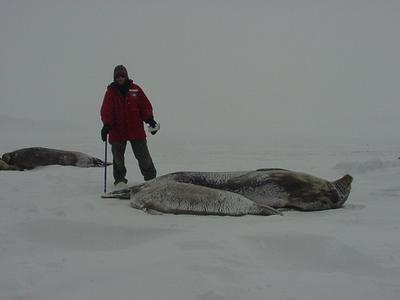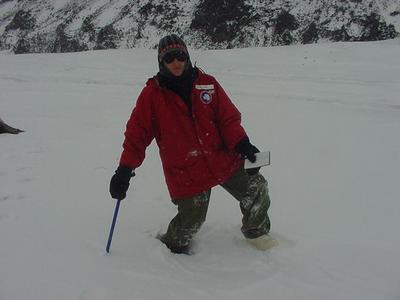12 November, 2000
FYI answer for 11/11/00
There are three species of 'pack' ice seals: Ross, Crabeater, and Leopard. There is one species of 'fast' ice seals: Weddell.
Pack ice is an ice flow that has broken from fast ice that remains attached to the land. Fast ice is ice that is fastened to the land.
As I was zooming across the snow-covered ice on my way to Turks Head today, I thought back to the past four days since my arrival here at Big Razorback. I now see adult male and female and male and female seal pups everyday. I also have been given the responsibility of taking care of an underwater video camera that is being used for the first time with this project. I keep the ice hole that it is in cleaned by chopping frozen ice and netting smaller ice so the hole does not freeze shut. We have remote controls so we can run the camera and view it from a television inside our living hut. We have seen many underwater behaviors. Mother seals are with the newly swimming pups. Young male seals are marking out their territory. We have also seen male vs. male confrontations a couple of times. The images are fascinating.
Today was 'census day' again. We are splitting into teams to go through the entire eighty-five square miles and record all the seals with tags and without tags, tag new ones or adults that may previously have been in the water. The count by the end of the day should be around 1,100. We move around the area by snowmobile until we get close to the animals. Then we move up to them on foot. It is best to stay back with the vehicles so they are calm and we can walk right up to them. The tags are small and on their tail flippers, so we sometimes have to move them to uncover the tag. Some get aggressive, especially the older females with pups lying near them.
When I walk on the ice, I have to carry an ic ax. hen I come up to an area that has been identified as a crack, I must poke through the snow to find out if the ax goes deep enough for me to continue walking, or if the ax goes through the snow into a water hole underneath. If that happens then I have to find where the other edge is. The cracks are typically six inches to two or three feet wide in this area. So then you just step or jump across. I have fallen into a wet crack once, my first day at work, and I've fallen into dry cracks at least twice every day. I've learned quickly how to recognize the snow patterns over most ice cracks. There are times when you just don't see them.
There are many geographical points of interest right here for me to observe every clear day. Mount Erebus is an active volcano here on Ross Island. Its elevation is almost 13,000 feet above sea level. Our huts are at sea level. It is an amazing site right out our hut doors, everyday. We also have the Royal Society Mountain range and Mount Discovery, which are large landmarks. Cape Evans, where one of Robert Scott's huts is still located, and Cape Royds, where a hut of Ernest Shackleton is located, are very close by.
Today I saw a penguin for the first time. Since we are so far from their typical location it was an unusual sight. It was an Adelie penguin all by itself. It wandered near our camp. Of course I grabbed my camera to take photos. An hour later it wandered right up to our huts and headed to the open ice cracks.
FYI
If you ________ into a wet ice crack, _________ for help, clamber out as quickly as possible, and ________ in fresh snow on the surface.

My first penguin sighting

Just a few of many seals that we count and identify by tags on their tail flippers

Taking census on 'Census Day', which we try to do every three to four days

This is just a 'little' crack.
Contact the TEA in the field at
.
If you cannot connect through your browser, copy the
TEA's e-mail address in the "To:" line of
your favorite e-mail package.
|
